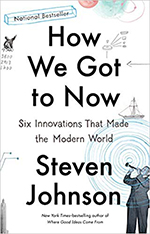25 April 2019
How We Got To Now, by Steven Johnson
Posted by Callan Bentley
 I was very impressed with Steven Johnson’s The Invention of Air when I read it last summer. So recently, I decided to sample another of his books, this one a six-part microhistory about innovations that altered the course of human history. The six are: 1) cleanliness/hygiene (specifically in medicine and drinking water), 2) measurement of time, 3) glass (think lenses!), 4) understanding of light, 5) refrigeration, and 6) the recording and playback of sound.
I was very impressed with Steven Johnson’s The Invention of Air when I read it last summer. So recently, I decided to sample another of his books, this one a six-part microhistory about innovations that altered the course of human history. The six are: 1) cleanliness/hygiene (specifically in medicine and drinking water), 2) measurement of time, 3) glass (think lenses!), 4) understanding of light, 5) refrigeration, and 6) the recording and playback of sound.
The six part structure recalled for me another recent microhistory, A History of the World in Six Glasses, but Johnson’s book has an edge that makes it the better of the two. I think this is because he views these innovations in a deep context that leads enthusiastically in unexpected directions. He dubs these “hummingbird effects,” a shout-out to the well-established notion of a butterfly effect (wherein small perturbations cause large effects), with the distinction that with hummingbird effects, the chain of causality can be followed through logic and documentation. It’s knowable, in other words, unlike the chaos implied in the butterfly effect. The “hummingbird” moniker comes from the evolution of flowering plants during the Cretaceous, an innovation that is a classic example of co-evolution, between plants and insects. But once flowers were established as a thing on Earth (a nectar-rich thing), then it opened up a new niche for other organisms to tap into them as a resource. But to efficiently get nectar out of a flower, a bird needs to hover, and hummingbirds evolved to do this with a unique wing structure and flight pattern. That permutation of bird evolution wasn’t something that could have been foreseen from the perspective of the first primordial flowers of the late Mesozoic, but it did follow as an actual real-world consequence.
Similarly, Gutenberg’s invention of the printing press not only spread ideas and literacy, but it also showed a lot of people that they were farsighted, and would be able to read much more easily with curved pieces of glass perched just in front of their eyeballs. Gutenberg’s invention provided a shot in the arm to the lens-crafting industry, which itself precipitated numerous innovations as those lenses were manipulated to make distant things seem closer, or small things seem bigger. Johnson has a distinctive, polymathic way of viewing history that results in fascinating stories, well-organized and well-articulated. I found this a fascinating read (well, a fascinating listen, since I listened to the audiobook version on my commute – an act directly consequent to one of the six innovations explored in the book!).
These ideas were also the basis for a PBS series in 2014, which I had missed until writing this blog post. I’ll bet it would be comparably engaging.


 Callan Bentley is Associate Professor of Geology at Piedmont Virginia Community College in Charlottesville, Virginia. He is a Fellow of the Geological Society of America. For his work on this blog, the National Association of Geoscience Teachers recognized him with the James Shea Award. He has also won the Outstanding Faculty Award from the State Council on Higher Education in Virginia, and the Biggs Award for Excellence in Geoscience Teaching from the Geoscience Education Division of the Geological Society of America. In previous years, Callan served as a contributing editor at EARTH magazine, President of the Geological Society of Washington and President the Geo2YC division of NAGT.
Callan Bentley is Associate Professor of Geology at Piedmont Virginia Community College in Charlottesville, Virginia. He is a Fellow of the Geological Society of America. For his work on this blog, the National Association of Geoscience Teachers recognized him with the James Shea Award. He has also won the Outstanding Faculty Award from the State Council on Higher Education in Virginia, and the Biggs Award for Excellence in Geoscience Teaching from the Geoscience Education Division of the Geological Society of America. In previous years, Callan served as a contributing editor at EARTH magazine, President of the Geological Society of Washington and President the Geo2YC division of NAGT.